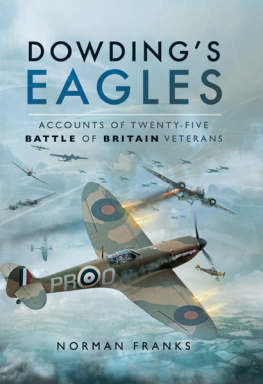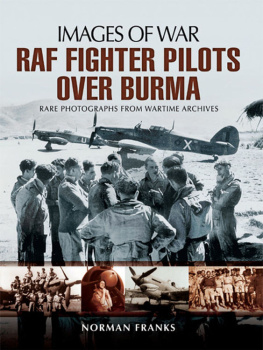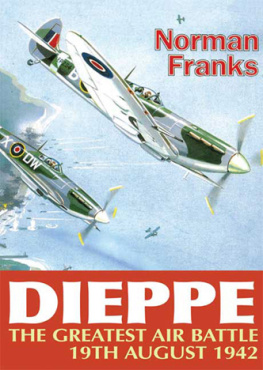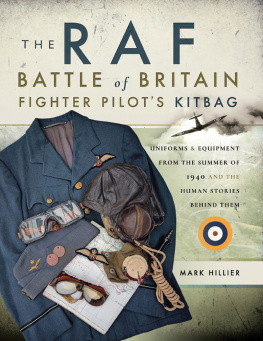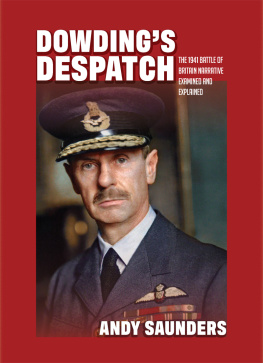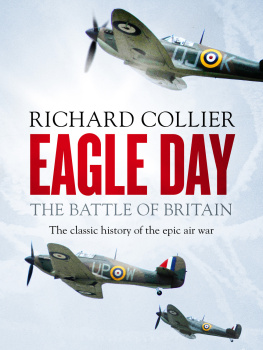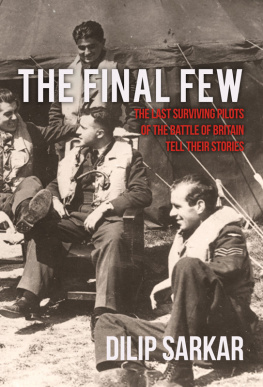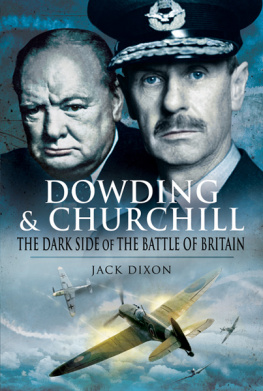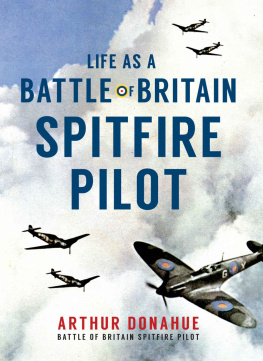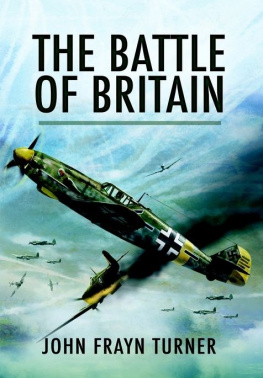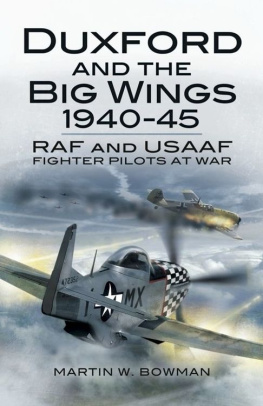First published in Great Britain in 2015 by
Pen & Sword Aviation
an imprint of
Pen & Sword Books Ltd
47 Church Street
Barnsley
South Yorkshire
S70 2AS
Copyright Norman Franks 2015
ISBN: 978 1 47384 420 9
PDF ISBN: 978 1 47384 423 0
EPUB ISBN: 978 1 47384 421 6
PRC ISBN: 978 1 47384 422 3
The right of Norman Franks to be identified as the Author of this Work has been asserted by him in accordance with the Copyright, Designs and Patents Act 1988.
A CIP catalogue record for this book is available from the British Library
All rights reserved. No part of this book may be reproduced or transmitted in any form or by any means, electronic or mechanical including photocopying, recording or by any information storage and retrieval system, without permission from the Publisher in writing.
Typeset in Ehrhardt by
Mac Style Ltd, Bridlington, East Yorkshire
Printed and bound in the UK by CPI Group (UK) Ltd,
Croydon, CRO 4YY
Pen & Sword Books Ltd incorporates the imprints of Pen & Sword Archaeology, Atlas, Aviation, Battleground, Discovery, Family History, History, Maritime, Military, Naval, Politics, Railways, Select, Transport, True Crime, and Fiction, Frontline Books, Leo Cooper, Praetorian Press, Seaforth Publishing and Wharncliffe.
For a complete list of Pen & Sword titles please contact
PEN & SWORD BOOKS LIMITED
47 Church Street, Barnsley, South Yorkshire, S70 2AS, England
E-mail:
Website: www.pen-and-sword.co.uk
Contents
Acknowledgments
M y thanks go to Paul Baillie for archive help with decoration citations, etc. Also to the staff of the Reference Department of the Ilkeston Library Derbyshire. Photographs have come from many sources quite apart from my own archive built up over fifty years, but also from friends and fellow aviation historians Chris Shores, Wojtek Matusiak and Chris Thomas. Most of the rest came from many of the former pilots I met or corresponded with over the years.
Foreword
E very year the British people celebrate the anniversary of the Battle of Britain. Ever since Group Captain Douglas Bader DSO DFC led a group of surviving pilots from that important victory, on 15 September 1945, there has always been some form of commemoration on this day, known as Battle of Britain Day. Over the years many RAF stations opened their gates to the general public, holding flying events, church services, dinners, and so on. The 25th and 50th anniversaries were celebrated a little more lavishly and no doubt the 75th will be the same.
On Battle of Britain Day we always remember the 544 men of Fighter Command who died during the Battle, which is as it should be, but we must also remember those who survived after the end of October 1940. Many went on to continue fighting with the RAF over the next few years, many of them falling in various parts of the world, but many survived the war. Those who did survive have now reached the twilight of their years; indeed only a comparative handful remain alive today. As one famous actor in an equally famous film said: The problem with being one of the few is that we get fewer and fewer.
As this 75th anniversary arrives, this book commemorates and remembers a few of the Few, so named by Winston Churchill in the House of Commons on 20 August 1940. His now famous speech included the words: Never in the field of human conflict was so much owed by so many to so few. The minibiographies in this book detail the service of some of those pilots, most of whom did survive the war, each with distinguished war service. Sadly most have now departed this world, but their names are remembered with pride.
There are two main reasons why I chose the ones I did: a number of them I had the privilege to meet; while others had incredible adventures in the RAF and I felt that their achievements had been overlooked by historians. Their stories are exceptional, as you will read. However, let us not forget that these are, or were, just ordinary men, but men who had that little bit of extra skill and luck. We shall not see their like again.
Chapter 1
Flying Officer N leC Agarzarian
I said in the foreword that this book remembers survivors of the Battle of Britain and the war, and this first story deals with a pilot who did not survive to see peace, although his Spitfire did survive, and is still with us today. I have always been fascinated with this particular pilot.
Noel LeChevalier Aggy Agazarian was born on 26 December 1916, the son of an Armenian father, Berge Agazarian, and a French mother, Jacqueline Marie-Louise le Chevalier. Berge Agarzarian had come to England in 1911 to escape persecution and had set up what became a very successful electrical business.
Noel was the third of four brothers, and there were also two sisters. All four brothers were educated at Dulwich College, where Noel excelled as an athlete. He was in the first Rugby XV, captained the swimming and boxing teams and was awarded the Victor Ludorum for his sporting achievements. In 1935 he went to Wadham College, Oxford, taking an honours degree in jurisprudence three years later.
While at university, he was one of many who joined the university Air Squadron. Upon leaving, he joined the Royal Air Force Volunteer Reserve, being commissioned in February 1939. The three brothers who each served with the RAF may well have had their interest in aviation stimulated by their mother who, soon after the end of the First World War, purchased a war surplus Sopwith Pup fighter aeroplane for the ridiculous sum of 5 at a Croydon auction and had it brought home and installed in the familys back garden so that her children could play with it.

Flying Officer Noel LeC Agazarian RAuxAF, flew with 609 Squadron in the Battle of Britain. Many of his sorties were in Spitfire R6915 which today hangs in the Imperial War Museum, Lambeth, London.
When war was declared in September 1939 Noel was immediately called up and went to No. 3 Initial Training Wing at Hastings on the Sussex coast. Here he was to meet a similarly minded young college graduate, Richard Hillary, later the famed author of the book The Last Enemy. In his book Hillary described Noel as having a pleasantly ugly face and being cosmopolitan by nature, intelligent and a brilliant linguist. Hillary also described Noels flying as rough, slap-dash, and with touches of brilliance.
That November they were both posted to No. 15 Flying Training School at RAF Lossiemouth, and having completed the course moved to No. 1 School of Army Co-operation at Old Sarum in early May 1940. This might well have led to a career in Army Co-operation, but fortunately they both showed promise as fighter pilots, so on 23 June Agazarian went to No. 5 Operational Training Unit at Aston Down, converting to single-seat fighters, namely Spitfires. Once converted, and with the Battle of Britain having started, Noel was posted to No. 609 Squadron at RAF Middle Wallop. Hillary, in turn, went to 603 Squadron. Both were auxiliary squadrons, one of a number formed to be manned by weekend airmen. 609 was known as the West Riding Squadron, that began life at RAF Yeadon, Yorkshire as a bomber unit in 1936 but by 1939 had been reorganised to day fighters.
No. 609 Squadron was to be heavily involved in the Battle of Britain, under the command of Squadron Leader H S Darley DSO, and was to have a number of very successful fighter pilots among its complement. John Dundas was one, John Bisdee (qv), Johnnie Curchin, Frankie Howell, David Crook, Keith Ogilvie and James McArthur were others of note. Later in the Battle, 609 received three early American volunteers fighting alongside them, Andy Mamedorf, Red Tobin and Vern Keough. The squadron, while it continued to have Middle Wallop as its main base, often used Warmwell, located southeast of Dorchester and north-east of Weymouth. When German raiders were expected to come into the Weymouth or Portland areas, 609 would fly down and operate from here and return to Wallop each evening.
Next page
